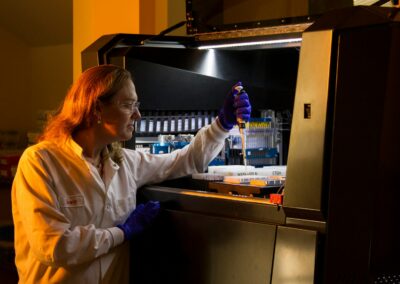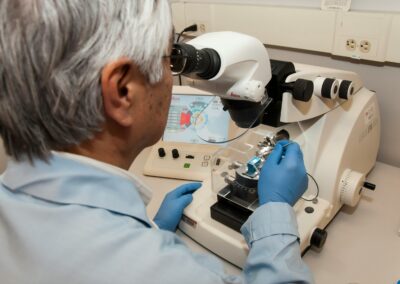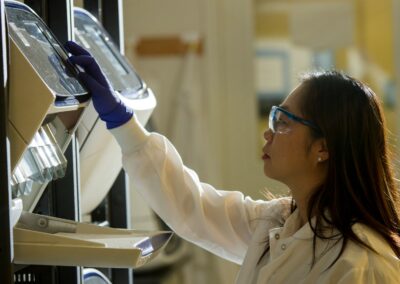Exploring Responsible Practices in Biotechnology
Introduction to Genetic Engineering for Environmental Conservation
The use of genetic engineering for environmental conservation represents a groundbreaking approach to addressing some of the most pressing ecological challenges of our time. By leveraging advanced biotechnological techniques, scientists can modify the genetic makeup of organisms to enhance their ability to adapt to changing environments, restore ecosystems, and protect endangered species. In regions like Saudi Arabia and the UAE, where environmental sustainability is a key component of national development strategies, the potential of genetic engineering offers both exciting opportunities and significant ethical considerations. Understanding how to balance these benefits and risks through responsible practices is crucial for ensuring that genetic engineering contributes positively to environmental conservation efforts.
Genetic engineering involves altering the DNA of organisms to produce desired traits, such as increased resilience to environmental stressors, improved reproductive success, or enhanced capabilities for bioremediation. In cities like Riyadh and Dubai, where innovative solutions are being sought to combat desertification, water scarcity, and biodiversity loss, genetic engineering can play a pivotal role. For example, genetically modified plants with enhanced drought resistance could help sustain agriculture in arid regions, while engineered microbes could be used to clean up oil spills and other pollutants.
However, the application of genetic engineering in environmental conservation also raises several ethical and ecological concerns. The potential for unintended consequences, such as the disruption of existing ecosystems or the creation of new invasive species, necessitates careful consideration and robust regulatory frameworks. In regions like Saudi Arabia and the UAE, where maintaining ecological balance is critical, implementing ethical guidelines and best practices is essential for mitigating these risks. By fostering a culture of responsible innovation, policymakers and scientists can harness the potential of genetic engineering while safeguarding the environment.
The Potential Benefits of Genetic Engineering for Conservation
The potential benefits of genetic engineering for environmental conservation are vast and varied, offering new tools for enhancing biodiversity, restoring degraded ecosystems, and mitigating the impacts of climate change. One of the most significant advantages is the ability to create genetically modified organisms (GMOs) that are better suited to withstand environmental stressors. For instance, developing crops with enhanced tolerance to drought, heat, and salinity can improve food security in arid regions like those in Saudi Arabia and the UAE. These genetically engineered crops can thrive in harsh conditions, reducing the need for water and chemical inputs and promoting sustainable agricultural practices.
Another promising application of genetic engineering is in the field of wildlife conservation. By modifying the genetic makeup of endangered species, scientists can enhance their reproductive success, increase resistance to diseases, and improve their ability to adapt to changing habitats. In regions like Riyadh and Dubai, where preserving biodiversity is a priority, these advancements can help protect vulnerable species and support ecosystem resilience. For example, genetic engineering could be used to bolster the populations of endangered native plants and animals, ensuring their survival for future generations.
Additionally, genetic engineering offers innovative solutions for environmental remediation. Engineered organisms, such as bacteria and fungi, can be designed to break down pollutants and clean up contaminated sites. This bioremediation approach can be particularly valuable in industrial regions where pollution poses a significant threat to ecosystems and human health. In technologically advanced areas like the UAE and Saudi Arabia, employing genetically engineered microbes to address environmental contamination can enhance sustainability and promote a cleaner, healthier environment.
Balancing Benefits and Risks Through Ethical Practices
While the benefits of genetic engineering for environmental conservation are substantial, it is crucial to balance these advantages with the potential risks through ethical practices and robust regulatory frameworks. One of the primary concerns is the possibility of unintended ecological impacts. Introducing genetically modified organisms into the environment could disrupt existing ecosystems, outcompete native species, or even create new invasive species. To mitigate these risks, thorough environmental impact assessments and long-term monitoring are essential. In regions like Saudi Arabia and the UAE, where ecological balance is delicate, adopting a precautionary approach to genetic engineering can help prevent adverse outcomes.
Ethical considerations also include the potential for genetic engineering to exacerbate existing inequalities. Access to biotechnological advancements may be unevenly distributed, with wealthier nations and communities benefiting more than others. Ensuring equitable access to the benefits of genetic engineering is crucial for promoting social justice and environmental sustainability. Policymakers in Riyadh and Dubai can play a pivotal role in advocating for inclusive policies that make genetic engineering technologies accessible to all, particularly marginalized and vulnerable populations.
Furthermore, fostering transparency and public engagement is vital for the responsible use of genetic engineering in environmental conservation. Open communication about the goals, methods, and potential impacts of genetic engineering projects can build public trust and support informed decision-making. Engaging stakeholders, including local communities, environmental organizations, and industry leaders, in the development and implementation of genetic engineering initiatives can enhance their legitimacy and effectiveness. In regions like the UAE and Saudi Arabia, promoting a culture of transparency and collaboration can ensure that genetic engineering projects are conducted ethically and with broad societal support.
Leadership and Management in Ethical Genetic Engineering
Effective leadership and management are essential for implementing and upholding ethical guidelines in genetic engineering for environmental conservation. Leaders in research institutions, government agencies, and industry must prioritize ethical practices and foster a culture of responsibility. This involves developing comprehensive policies that promote ethical behavior, providing training on ethical standards, and ensuring that researchers understand the importance of conducting their work responsibly. In regions like Saudi Arabia and the UAE, where technological innovation and environmental sustainability are central to national goals, strong ethical leadership can drive responsible scientific progress.
Project management skills are also vital for ensuring that genetic engineering projects adhere to ethical guidelines. Project managers must oversee the planning, execution, and reporting of research activities, ensuring that ethical considerations are integrated at every stage. This involves coordinating multidisciplinary teams, managing resources efficiently, and conducting regular audits to ensure compliance with ethical standards. In cities like Riyadh and Dubai, where large-scale research initiatives are common, effective project management can support the ethical conduct of genetic engineering and enhance its impact.
Collaboration between policymakers, researchers, and industry leaders is essential for developing and enforcing ethical guidelines in genetic engineering. By working together, these stakeholders can create robust frameworks that balance innovation with ethical responsibility. In the UAE and Saudi Arabia, fostering dialogue and cooperation between the public and private sectors can enhance the governance of genetic engineering and ensure that advancements benefit society as a whole. This collaborative approach is key to addressing the ethical challenges of modern genetic research and promoting sustainable scientific development.
Conclusion
The role of ethical guidelines in genetic engineering for environmental conservation is critical for ensuring integrity, scientific rigor, and societal benefit. In regions like Saudi Arabia and the UAE, where technological innovation and research excellence are prioritized, adhering to ethical standards is essential for advancing knowledge responsibly. By promoting integrity and scientific rigor, addressing ethical considerations in emerging technologies, and fostering strong leadership and collaboration, researchers and policymakers can navigate the complexities of genetic research and harness its potential for the greater good. As genetic research continues to evolve, maintaining a strong ethical foundation will be key to achieving breakthroughs that enhance human health, agricultural productivity, and overall quality of life.
—
#geneticengineering #environmentalconservation #biotechnology #ethicalpractices #AI #Blockchain #Metaverse #SaudiArabia #UAE #Riyadh #Dubai #businessleadership #managementskills























